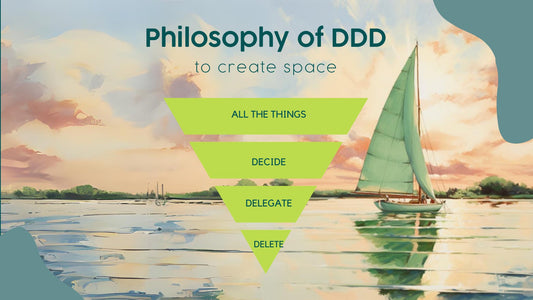
Philosophy of DDD
Share
I want to introduce a concept that has the potential to transform the way we handle tasks and streamline our work processes—DDD: Decide, Delegate, Delete.
What is DDD, and Why Does it Matter?
In the realm of productivity, DDD represents a powerful trio—Decide (or Discuss), Delegate, Delete. The beauty of this concept is that it puts each and every thing on a path. Ideas, tasks, projects, to-dos, everything. Instead of drowning in the chaos, we apply the DDD method and- get this- actually get caught up.
Prep:
Put all the things on a list. I mean everything. I recommend using a google sheet. If you decide to call me to help, we can share the list.
Step 1: Decide (or Discuss)
Consider the first item and think about what it will cost in time and dollars. What does the path look like for this item, idea, or task? Now we decide if we move this item to the next step- Delegation. If the idea isn’t worth doing the steps, then it isn't worth being on this list. If that’s the case, then delete it because it’s just taking up space.
Step 2: Delegate
Ideas: Put it in motion. Take the first step to realize this idea. Send the email to get it started, purchase the material, or set a date or meeting.
Tasks: Is it something you need to do? Put it on your actual to-do list. Is it something you need someone else to do? Send the email with a full explanation of the task to the person who needs to do it. When tasks sit around with no path to completion, guess what? They don’t get completed.
Delegate can mean delegate to a person or to another workflow. Does your “list of all the things” have items that can be assigned to categories such as customer requests or trending designs? If so, delegate those items to another list. Now they are on a path.
Step 3: Delete
When an item is done or delegated to be done, and–here's the liberating part—delete it. Yes, delete the item from your list, both digitally or mentally. Why? Because it's resolved, either through discussion, decision, or delegation. Picture the satisfaction of a shrinking “everything list,” and the mental clarity that follows.
Bringing DDD to Life: A Practical Example
Delegating isn't just about passing the buck; it's about installing tools that prevent issues from resurfacing. If there is a problem that is recurring, consider that item’s path. Where are we going wrong on that path? The issue may be resolved by adding a checkbox to a training checklist or to a preparation checklist. By delegating the issue further back on its “path,” we can resolve the issue before it happens, creating space in your day to day. These tools, born from our experiences, should be living documents that evolve with our needs.
Conclusion
DDD isn't just a concept; it's a philosophy that can revolutionize the way we work. By engaging in discussions, making decisions, delegating effectively, and eliminating unnecessary tasks, we create space for the things you really want to do and, let’s be honest, the things that make you money.
Imagine your “list of all the things,” shrinking over time and when each thing has gone through DDD. This might sound crazy but it is possible to be caught up. You can do this. I can help.
Onward and upward!


